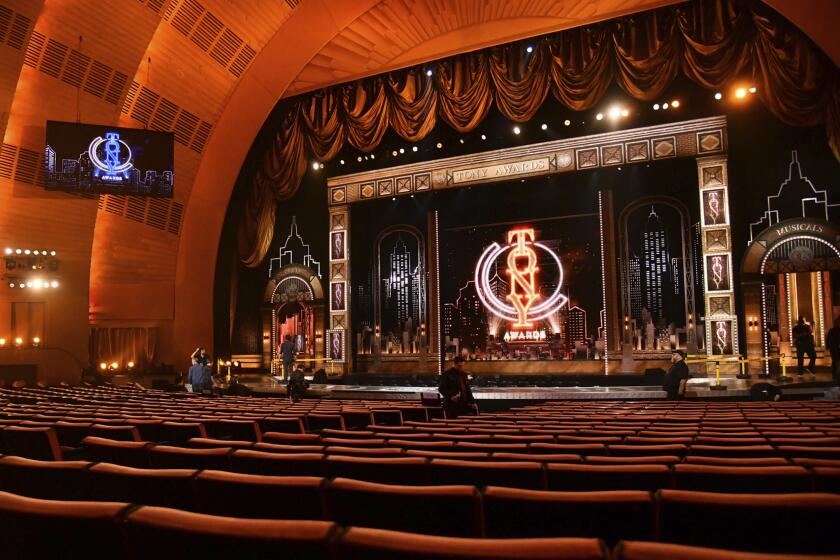Time to think inside the box
- Share via
PHOENIX — Let’s be honest. Nobody running a massive media company these days -- or working for one, or fleeing from one, or bravely enough trying to land a job at one -- knows quite what the future holds for the journalism business. Television news, particularly on the 24/7 cable channels, has lately managed the desperate and paradoxical trick of turning crisis coverage into its only reliable staple, the anchors clinging by their manicured fingernails to one sky-is-falling Big Story until the next one moves into view. Out of necessity, meanwhile, most American newspapers are becoming on-the-fly, do-more-with-less combinations of print, pixels, video and sound, working hard to chase a young generation of readers who, inconveniently enough, don’t really spend any time reading.
That uncertainty causes plenty of anxiety for those of us riding the media-world roller coaster every day, but for Los Angeles architect Steven Ehrlich, they’ve provided highly useful fodder for the most significant project of his varied career. If his Walter Cronkite School of Journalism and Mass Communication for Arizona State University, which anchors the school’s new campus in downtown Phoenix, doesn’t rise to the level of great architecture, it is a near-perfect piece of architectural symbolism: a happily cobbled-together, chewing-gum-and-bailing-wire building that manages to mine some bright optimism -- and moments of real human connection -- from the depths of an industry’s identity crisis.
Walter Cronkite himself, who is 92 and has been associated with the school for two decades, was known for a no-nonsense catch-phrase that now has the creaky familiarity of cliche but was originally, in its way, as impressively, confidently pared down as a Bauhaus facade: “And that’s the way it is.” Ehrlich’s design, developed with an associate in the firm, Mathew Chaney, flows from the conviction that such certainty has drained out of the news business and that the only honest way to approach journalism is to ditch the confidently omniscient pose of the Cronkite generation and try to tell your audience as snappily and memorably as possible how things look from your little corner of the world. In the best-case scenario for the news business, enough of those corner-of-the-world moments, produced by enough smart reporters and arranged artfully by enough persevering editors, can add up to a product that better reflects the culture we actually inhabit than a half-hour network newscast ever could.
The $56-million, 235,000-square-foot Cronkite School is an ungainly, six-story stack of classrooms, broadcast studios and offices. It was produced in a remarkably short period of time: Ehrlich sat down to begin the design in fall 2006, construction started in February 2007, and the students and staff were moving in before Labor Day of this year. (An official ribbon-cutting was held in November.) Relying on the increasingly prominent “design-build” construction method, in which the contractor leads the overall construction team -- and groundbreaking often occurs while the architects are still figuring out the last details of their design -- the Cronkite Center sprouted, oddly enough, like a mushroom in the desert, taking about 22 months from start to finish. (Many bathroom renovations take that long.)
A fit for downtown
For Ehrlich, whose portfolio includes a number of Westside houses as well as a forthcoming arts building for UC Irvine, the design-build process seems to have been energizing; his firm is using the same method on its design for a second building for Arizona State, this one a $140-million science and technology center on the main campus in Tempe.
The Cronkite School is a huge box of a building wrapped in glass and concrete block and topped by sheets of corrugated metal in ASU’s colors, maroon and gold. It has a shifting personality, looking from some angles like a stable addition to the Phoenix skyline and from others like the skittish offspring of a satellite dish and a shipping container. The architects have taken a chunk out of one corner to make room for the main entrance, which sits behind a skinny concrete column and beneath an electronic news ticker. Shops line one side of the building at ground level.
The interior is dominated by a double-height gathering space called the First Amendment Forum, which combines tables, chairs and an endless supply of plasma-screen TVs beneath an angled, vent-wood ceiling. Ehrlich has called it a living room for the building, and as a design gesture it clings hopefully to the idea that the media can still provide a virtual public square for American life. But it more clearly works as a place for actual human interaction: for students to meet in impromptu groups or to bump into their instructors or one another, underlining the notion that broadcast and print students are still working toward careers in the same business.
In addition to its emphasis on speed and economy, the Cronkite School has a significant urban role to play. It is the first ground-up building on ASU’s downtown campus, which is emerging as a vital satellite to the Tempe campus. The school opens on one side to a pedestrian walkway called Taylor Mall (which has been smartly filled with a variety of drought-friendly plants by Ten Eyck Landscape Architects) and sits across Central Avenue from the city’s new $30-million, 2.7-acre Downtown Civic Space Park, which will open next year. Running down the middle of Central Avenue -- becoming, in a way, part of the Cronkite School’s architecture, and certainly part of its optimism about the intersection of journalism and cities -- is a new light-rail track that will carry students to and from Tempe in about 25 minutes.
Like a blog post
As a 23-year-old Gawker correspondent would say: Wait, what? Phoenix -- car-friendly, sprawling Phoenix, the only city that makes Los Angeles look dense and transit-friendly -- has a light-rail system about to open through the middle of its downtown? ASU’s campus in Tempe is poised to be better connected to Phoenix than, say, UCLA is to the rest of Los Angeles? Yes, to the chagrin of Southern Californians, it does and it is. The light-rail system will make its debut this month, with a stop about a half-block from the entrance to the Cronkite School.
In an earlier era, buildings for media companies and journalism schools did their best to tap into the imposing power of Olympian symbolism, adding oversized colonnades to their front facades or -- as in the case of the CBS headquarters in New York, a sleek and intimidating piece of skyscraper architecture by Eero Saarinen known as Black Rock -- aiming for a scale and mien that might intimidate potential employees and subjects of news coverage alike. The Cronkite School is one of those Olympian buildings after it has collapsed into a heap but somehow managed to keep the lights on, the cameras rolling and the servers humming. It is the brightly colored rubble out of which a new model of multi-tasking journalism is struggling to emerge: diminished in significant ways, certainly, but nimbler and savvier than in the days of fat daily newspapers and fatter profit margins.
There are drawbacks to the quick-draw approach, of course. Pieces of architecture, like pieces of writing, benefit from time for reflection and development, for revisions and second thoughts, for circling back, reassessing, and trying again. Though the comparison seems almost too easy, the Cronkite School is the architectural equivalent of a blog post: Quick out of the blocks and full of the energy that comes with youth and speed but ultimately concerned primarily with surface effects. It is a brisk, forward-looking monument to making do.
--
christopher.hawthorne@latimes.com
More to Read
The biggest entertainment stories
Get our big stories about Hollywood, film, television, music, arts, culture and more right in your inbox as soon as they publish.
You may occasionally receive promotional content from the Los Angeles Times.











